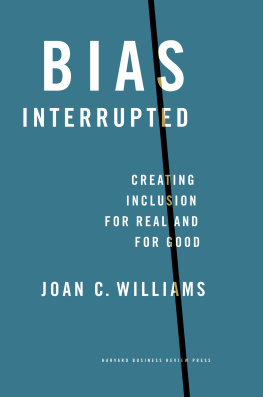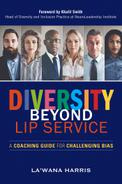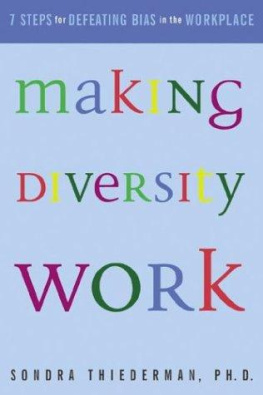Erasing
Institutional
Bias
Erasing
Institutional
Bias
How to Create Systemic Change for Organizational Inclusion
Tiffany Jana
and Ashley Diaz Mejias

Erasing Institutional Bias
Copyright 2018 by Tiffany Jana and Ashley Diaz Mejias
All rights reserved. No part of this publication may be reproduced, distributed, or transmitted in any form or by any means, including photocopying, recording, or other electronic or mechanical methods, without the prior written permission of the publisher, except in the case of brief quotations embodied in critical reviews and certain other noncommercial uses permitted by copyright law. For permission requests, write to the publisher, addressed Attention: Permissions Coordinator, at the address below.
|
|---|

| Berrett-Koehler Publishers, Inc.
1333 Broadway, Suite 1000
Oakland, CA 94612-1921
Tel: (510) 817-2277, Fax: (510) 817-2278
www.bkconnection.com |
Ordering information for print editions
Quantity sales. Special discounts are available on quantity purchases by corporations, associations, and others. For details, contact the Special Sales Department at the Berrett-Koehler address above.
Individual sales. Berrett-Koehler publications are available through most bookstores. They can also be ordered directly from Berrett-Koehler: Tel: (800) 929-2929; Fax: (802) 864-7626; www.bkconnection.com Orders for college textbook/course adoption use. Please contact BerrettKoehler: Tel: (800) 929-2929; Fax: (802) 864-7626.
Distributed to the U.S. trade and internationally by Penguin Random House Publisher Services.
Berrett-Koehler and the BK logo are registered trademarks of Berrett-Koehler Publishers, Inc.
First Edition
Paperback print edition ISBN 978-1-5230-9757-9
PDF e-book ISBN 978-1-5230-9758-6
IDPF e-book ISBN 978-1-5230-9759-3
Digital audio ISBN 978-1-5230-9761-6
2018-1
Interior design and production: Dovetail Publishing Services
Cover designer: Dan Tesser / Studio Carnelian
Dedications
Tiffany Jana
To my eldest daughter, Naomi Vickers, an inspiration to all around her.
Ashley Diaz Mejias
For my daughters Belen, Maisy, and Yves.
With a soul-dwelling awe at the light that lives in each of you.
Contents
by Jay Coen Gilbert, cofounder, B Lab
Introduction How Ordinary People Can Identify and
Eliminate Institutional Bias
Foreword
by Jay Coen Gilbert, cofounder, B Lab,
serving the B Corporation movement
Only 43 percent of B Labs staff who are people of color feel they can bring their whole selves to work, compared to 96 percent of their white coworkers.
The words hit me like a punch to the gut. As a person who cares deeply about equity, I have spent considerable time and resources and dedicated my professional and civic life for the last decade to building a more equitable society and a more inclusive economy, so reading this statistic from a recent staff survey devastated me.
It also shouldnt have surprised me.
B Lab, the organization I cofounded in 2006, is the nonprofit behind the global B Corporation movement. B Corporations redefine success in businessthey compete to be best for the world and meet the most rigorous standards of social and environmental performance, public transparency, and legal accountability to balance profit and purpose. There are roughly 2,500 Certified B Corporations in more than 150 industries and 50 countries all dedicated to a single unifying goalusing the power of business to create an inclusive economy that works for everyone. B Corps have been called one of the 20 Moments That Mattered over the last 20 years by Fast Company, and one of the Business Trends to Master by Fortune. B Corps have been lauded by a Nobel Prizewinning economist, a former US president, former US secretaries of labor and state, and dozens of governors across the political spectrum who are inspired by B Corporations new model of inclusive corporate governance that ensures consideration of all stakeholdersnot just shareholderswhen making decisions. B Lab has been honored as a recipient of the Skoll Award for Social Entrepreneurship and of the McNulty Prize at the Aspen Institute. And yet, only 43 percent of B Labs staff who are people of color feel they can bring their whole selves to work, compared to 96 percent of their white coworkers.
Houston, we have a problem.
B Lab, an organization of roughly 65 people, is 68 percent whitewhiter than the US population, which according to the 2016 estimates by the US Census Bureau is 61 percent white, non-Hispanic white. That wasnt what surprised me. What surprised me was that the staff survey suggested that our culture was more like 98 percent white. More specifically, white middle-to- upper-class culture. I learned that there were things I never noticed that were negatively impacting our teams experience at work. For example, our primary office location is in a largely white affluent suburb and that has created an unwelcoming environment for some team members. Other issues seemed to be about class and culture as well as the interconnected issue of race: our expense reimbursement policy assumes our colleagues have credit cards (we dont offer corporate cards) and is ignorant to the fact that some who do might be put in a tough spot if we reimbursed them after they needed to pay their monthly bill (more burdensome because research that suggests credit terms are often worse for people of color than for whites); personal shares at our weekly staff meeting, intended to build connection and community, often featured photos from a team members amazing travel experience or beautiful wedding, which for some had a must be nice for you dissonant ring; general office chatterwhether in the kitchen, on Slack, or during GoToMeetingsreflected the life experiences, interests, and digital feeds of our team, and since that team was largely white and privileged, or then just being around the office was a daily reminder of otherness and an obstacle for some to bring their whole selves to work every day. Compounding these issues, B Lab had almost no people of color in leadership, creating a lack of role models for career development and compounding a sense of isolation. Perhaps that is why people of color at B Lab were more likely to experience social interactions at work as poor or fair vs. good or great.
One of the things we learn in Dr. Janas and Diaz Mejias book Erasing Institutional Bias is to be data-driven. The quantitative and qualitative results of our staff survey were a cold-shower reminder for me to look at the data and not to trust blindly in my own personal experience, which may be quite different from the experience of others, including others whom I care about and think I know well. Despite the pain I felt learning this information, I would have been far more devastated had I and our management team remained oblivious any longer. Dataand the deeper understanding it can offercreates opportunities. This data gave us the information we needed to begin to improve the experiences, and hopefully the success and longevity, of people of color at B Lab. While we have a long way to go, changes to these policies, to our everyday business practices, and to our leadership team are underway. These changes will make us a stronger team that makes better decisions and builds a stronger, more inclusive global movement of people using business as a force for good.
Next page









